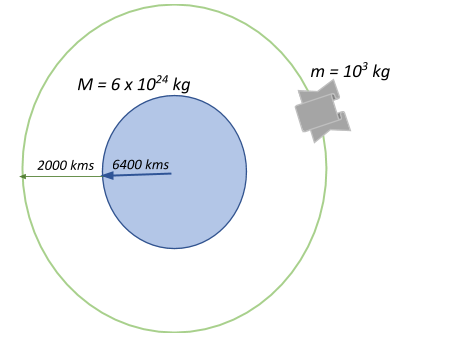
A satellite of mass $1000\;kg$ is supposed to orbit earth at a height of $2000\;km$ above the Earth’s surface. Find its time period. Mass of the Earth = $6 \times 10^{24}\;kg$.
Answer
478.8k+ views
Hint: Remember that for a satellite to stay in orbit there should be a balance between the gravitational and the centrifugal forces that it is subjected to. Additionally, by assuming that the satellite orbit traces a circular perimeter and calculating the orbiting velocity of the satellite from the balance of the abovementioned forces you can find the time period.
Formula used:
Centrifugal force: $F_{centrifugal} = \dfrac{m\;v^2}{r}$, where m is satellite mass, v is its velocity and r is the radius of its orbit.
Gravitational force: $F_{gravitational} = \dfrac{G\;M\;m}{r^2}$ , where G is the gravitational constant, M is the mass of the body around which satellite is orbiting, m is the satellite mass and r is the distance to the satellite from orbiting centre.
In general, for a circular orbit, time period $T = \dfrac{Perimeter}{Velocity} = \dfrac{2 \pi r}{v}$
Complete step by step answer:

Let us look at the forces that are acting on a satellite orbiting the earth.
Firstly, there is the earth’s gravitational force that tugs on the satellite and pulls it closer:
$F_{gravitational} = \dfrac{G\;M\;m}{r^2}$
Secondly, due to the circular motion of the satellite it experiences a centrifugal force that pushes that satellite away:
$F_{centrifugal} = \dfrac{m\;v^2}{r}$
Now the satellite maintains its orbit by balancing the gravitational force and the centrifugal force. At equilibrium $F_{gravitational} = F_{centrifugal} $:
$\Rightarrow \dfrac{G\;M\;m}{r^{2}} = = \dfrac{m\;v^2}{r} \Rightarrow v = \sqrt{\dfrac{GM}{r}}$
Here, $G$ is the Gravitational constant ($6.67 \times 10^{-11}\;Nm^2kg^{-2}$), M is the mass of the earth and r is the radius of the satellite orbit given by:
$r = R + h = 6400 + 2000 = 8400kms$
Therefore, $ v = \sqrt{\dfrac{GM}{r}} = \sqrt{\dfrac{6.67 \times 10^{-11} \times 6 \times 10^{24}}{8400 \times 10^3}} \Rightarrow v = 6.9\;kms^{-1}$
Now, for a circular orbit, time period $T = \dfrac{Perimeter}{Velocity} = \dfrac{2 \pi r}{v}$
$\Rightarrow T = \dfrac{2 \pi (8400 \times 10^3)}{6.9 \times 10^3} =7649.095\;s = 2.12 hrs$
Therefore, the time period of revolution for the satellite is 2.12 hrs.
Note:
Always remember to include the Earth’s radius in addition to the distance of the satellite from the Earth’s surface while considering orbital radius as the magnitude of influence of Earth’s gravity depends on the distance of the satellite from the orbiting centre which is the centre of the Earth.
Proceed cautiously while converting km or $kms^{-1}$ to $m$ or $ms^{-1}$ and account for every power of 10.
Formula used:
Centrifugal force: $F_{centrifugal} = \dfrac{m\;v^2}{r}$, where m is satellite mass, v is its velocity and r is the radius of its orbit.
Gravitational force: $F_{gravitational} = \dfrac{G\;M\;m}{r^2}$ , where G is the gravitational constant, M is the mass of the body around which satellite is orbiting, m is the satellite mass and r is the distance to the satellite from orbiting centre.
In general, for a circular orbit, time period $T = \dfrac{Perimeter}{Velocity} = \dfrac{2 \pi r}{v}$
Complete step by step answer:

Let us look at the forces that are acting on a satellite orbiting the earth.
Firstly, there is the earth’s gravitational force that tugs on the satellite and pulls it closer:
$F_{gravitational} = \dfrac{G\;M\;m}{r^2}$
Secondly, due to the circular motion of the satellite it experiences a centrifugal force that pushes that satellite away:
$F_{centrifugal} = \dfrac{m\;v^2}{r}$
Now the satellite maintains its orbit by balancing the gravitational force and the centrifugal force. At equilibrium $F_{gravitational} = F_{centrifugal} $:
$\Rightarrow \dfrac{G\;M\;m}{r^{2}} = = \dfrac{m\;v^2}{r} \Rightarrow v = \sqrt{\dfrac{GM}{r}}$
Here, $G$ is the Gravitational constant ($6.67 \times 10^{-11}\;Nm^2kg^{-2}$), M is the mass of the earth and r is the radius of the satellite orbit given by:
$r = R + h = 6400 + 2000 = 8400kms$
Therefore, $ v = \sqrt{\dfrac{GM}{r}} = \sqrt{\dfrac{6.67 \times 10^{-11} \times 6 \times 10^{24}}{8400 \times 10^3}} \Rightarrow v = 6.9\;kms^{-1}$
Now, for a circular orbit, time period $T = \dfrac{Perimeter}{Velocity} = \dfrac{2 \pi r}{v}$
$\Rightarrow T = \dfrac{2 \pi (8400 \times 10^3)}{6.9 \times 10^3} =7649.095\;s = 2.12 hrs$
Therefore, the time period of revolution for the satellite is 2.12 hrs.
Note:
Always remember to include the Earth’s radius in addition to the distance of the satellite from the Earth’s surface while considering orbital radius as the magnitude of influence of Earth’s gravity depends on the distance of the satellite from the orbiting centre which is the centre of the Earth.
Proceed cautiously while converting km or $kms^{-1}$ to $m$ or $ms^{-1}$ and account for every power of 10.
Recently Updated Pages
Can anyone list 10 advantages and disadvantages of friction

What are the Components of Financial System?

How do you arrange NH4 + BF3 H2O C2H2 in increasing class 11 chemistry CBSE

Is H mCT and q mCT the same thing If so which is more class 11 chemistry CBSE

What are the possible quantum number for the last outermost class 11 chemistry CBSE

Is C2 paramagnetic or diamagnetic class 11 chemistry CBSE

Trending doubts
The correct order of melting point of 14th group elements class 11 chemistry CBSE

One Metric ton is equal to kg A 10000 B 1000 C 100 class 11 physics CBSE

What is the specific heat capacity of ice water and class 11 physics CBSE

State the laws of reflection of light

Proton was discovered by A Thomson B Rutherford C Chadwick class 11 chemistry CBSE

Why does niobium have a d4s1 electron configuration class 11 chemistry CBSE




